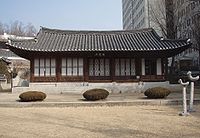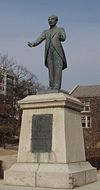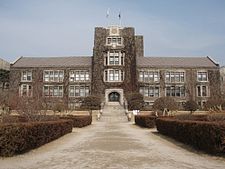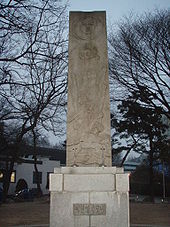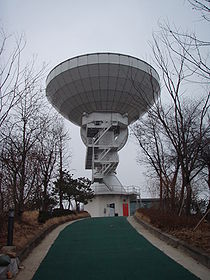- Yonsei University
-
Yonsei University 연세대학교 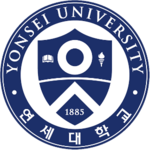
Motto The truth will set you free. (John 8:32)
진리가 너희를 자유케 하리라. (요한복음 8:32)Established Hospital established in 1885 by royal support, college installed in 1915. The university was established on January 5, 1957 by merger of the two institutions.[1] Type Private Religious affiliation Presbyterian President Kim, Han-Joong Academic staff 4,305 Admin. staff 6,714 Students 36,453 Undergraduates 25,152 Postgraduates 11,301 Location Seoul, Wonju, Incheon, Republic of Korea Campus Urban Colors Royal blue Mascot Eagle Website www.yonsei.ac.kr/eng/ 
Yonsei University Hangul 연세대학교 Hanja 延世大學校 Revised Romanization Yeonse Daehakgyo McCune–Reischauer Yŏnse Taehakkyo Yonsei University (연세대학교; 延世大學校) (Korean pronunciation: [jənseː]) is a Christian private research university, located in Seoul, South Korea. Established in 1885, it is one of the oldest universities in South Korea, the top private comprehensive universities in South Korea, and is widely regarded as one of the top three comprehensive universities in the country.[2]
Yonsei university is one of Korean universities ranked in all three ARWU World University Ranking, QS World University Rankings, and The Times World University Ranking in 2010, along with Seoul National University, KAIST, and POSTECH (Pohang University of Science and Technology).[3][4] Also, in 2011, Yonsei University was ranked the 129th in QS World University Rankings[5][6], and 190th in the world by Times Higher Education World University Rankings.[4]
The university was formally established in January, 1957 through the union of Yonhi College (연희전문학교; 延禧專門學校) and Severance Union Medical College (세브란스 의과대학; 세브란스 醫科大學). This was a result of a lasting bilateral cooperation between the two colleges which had begun in the 1920s. The institutions were new to Korea at the time of their inception — Yonhi College was one of the first modern colleges, founded originally as Chosun Christian College (조선기독교대학; 朝鮮基督教大學) in March, 1915, and Severance has its roots in the first modern medical center in Korea, Gwanghyewon (광혜원 廣惠院, House of Extended Grace), founded in April, 1885. As a tribute, the name 'Yonsei' was derived from the first syllables of the names of its two parent institutions, 'Yon; 연; 延' from Yonhi College and 'Sei; 세; 世' from Severance Union Medical College.
As of April 1, 2009, Yonsei University has a main campus in Seoul, a secondary campus in Wonju, South Korea, 26,530 undergraduate students, 11,437 graduate students, and 4,178 faculty members.[7]
Contents
History
Beginnings (1885 - 1916)
The Yonsei University Medical School dates back to April 10, 1885, when the first modern hospital to practice western medicine in Korea, Gwanghyewon, was established.
The hospital was founded by Horace Newton Allen, the American protestant missionary appointed to Korea by the Presbyterian Church in the U.S.A (from here on the Church). The hospital was renamed Jejungwon (제중원 濟衆院, House of Universal Helpfulness) on April 23. As there appeared numerous difficulties, the Church appointed Oliver R. Avison to run Jejungwon on July 16, 1893. Initially, Gwanghyewon was financed by the Korean government, while the medical staff was provided by the Church. However, by 1894 when the First Sino-Japanese War and Gabo reforms (갑오개혁) took place, the government was not able to continue its financial support and thus, management of Jejungwon now came fully under the Church. In 1899 Avison returned to the U.S. and attended a conference of missionaries in New York where he elaborated on the medical project in Korea. Louis H. Sevrance, a businessman and philanthropist from Cleveland, Ohio, was present and deeply moved. He later paid for the major portion of the construction cost of new buildings for the medical facility. Jejungwon (제중원) was renamed Severance Hospital in his name.
Jejungwon (later Severance Hospital) was primarily a hospital but it also performed medical education as an attachment. The hospital admitted its first class of 16 medical students selected through examinations in 1886, one year after its establishment. By 1899, Jejungwon Medical School was independently and officially recognized. Following the increase of diversity in missionary denominations in Korea, collaboration began to form — with time, Jejungwon began to receive medical staff, school faculty and financial support from the Union Council of Korean Missionaries (한국연합선교협의회; 韓國聯合宣敎協議會) in 1912. Accordingly, the medical school was renamed Severance Union Medical College in 1913.
The rest of Yonsei University traces its origins to Chosun Christian College, which was founded on March 5, 1915, by another American Protestant missionary sent by the Church, Horace Grant Underwood. Underwood became the first president, and Avison vice president. It was located at the YMCA. Courses began in April with 60 students and 18 faculty members.
Underwood died of illness on October 12, 1916, and Avison took over as president.
Under Japanese Rule(I) (1917 - 1936)
On August 22, 1910, Japan annexed Korea with the Japan-Korea Annexation Treaty. The first Governor-General of Korea, Terauchi Masatake, introduced Ordinance on Chosun Education (조선교육령; 朝鮮敎育令) in 1911, and subsequently Regulations on Professional Schools (전문학교 규칙) and Revised Regulations on Private Schools (개정사립학교 규칙) in March, 1915. These were intended to stifle private education in Korea; any establishment of schools, any change in school regulations, location, its purpose, coursework or textbooks must all be reported to and authorized by the governor-general, and all courses must be in Japanese. Severance Union College struggled to meet these requirements; school regulations and coursework were altered, faculty evaluated and enlarged, its foundation and its board clarified. It received its recognition as a professional medical school on May 14, 1917.[8] In 1922 the governor-general Makoto Saito issued Revised Ordinance on Chosun Education (개정조선교육령). It called for more strict qualification of the faculty, and Severance reacted obediently and further recruited more members with degrees from credited institutions in North America and Europe. Japan did not completely ignore the competence of this institution; in 1923 Severance recovered its right to give medical license to its graduates without state examination, a right which had been lost since 1912. Moreover in March, 1934, Japanese Ministry of Education and Culture further recognized Severance in allowing its graduates the right to practice medicine anywhere within Japanese sovereignty.
Oh Geung Seon (오경선; 吳兢善) became the first Korean president of Severance in 1934.
Ordinances in 1915 and 1922 also affected the fate of Chosun Christian College. First intended as a college, it was not legally recognized as such, since the Ordinance (1915) did not allow the establishment of Korean private colleges. Hence Chosun Christian College, now renamed Yonhi College, was formally accepted only as a professional school on April 17, 1917, then a joint project from diverse missionary denominations. However, Yonhi in reality had formed the organization and faculty becoming a university; it consisted 6 departments: humanities, agriculture, commerce, theology (this department did not open due to the differences among the founding denominations), mathematics & physics, and applied chemistry. The ordinances, furthermore, prohibited coursework in Korean history, its geography, or in Bible outside the department of theology; council of missionaries reacted with A Resolution on the Revised Educational Ordinance (개정교육령에 관한 결의문)[9] which carefully pointed out that Japan did not apply such rigorous absurdities to its private schools in mainland Japan.
After March First Independence Movement swept the peninsula in 1919, Japan somewhat relaxed its grip on Korea, and this is reflected in the Ordinance (1922). It ceased the arbitrary control of governor-general over the coursework and the qualification of faculty members, and altered its stance on strict separation of religion from all education. It also recognized Yonhi as a professional school equal to its counterparts in Japan, and permitted the Christian programs and the Bible in its coursework. Nevertheless, Japanese literature became mandatory in turn.[10] Under Japanese intervention, Korean history was taught under the name Eastern History and Korean language was taught whenever possible.[11]
Department of agriculture was closed after 1922 when only its first graduates left Yonhi. There were efforts to revive this department, without much success. However, Yonhi installed a training center for agricultural leaders on campus, with impressive results.[12]
Yonhi was liberal in its admission of non-Christians. Its policy was to admit non-Christians relatively freely and allow the majority Christian students to gradually influence and assimilate them.
Under Japanese Rule(II): The War Machine (1937 - 1945)
In the late 1930s, Japan again shifted its policy towards Korea in order to incorporate it to its scheme of expansionism. In August, 1936, the new Japanese Governor-General Jirō Minami began the assimilation of Koreans, in order to exploit them for military purposes; Governor-General enforced Sōshi-kaimei and Shintoism on Koreans, and began to recruit Koreans for Japanese war efforts. In April,1938 the third Ordinance on Chosun Education ordered the acceptance of Shintoism, voluntary removal of Korean language in coursework and further intensification of Japanese and Japanese history education. However, Yonhi Professional School did not follow suit and opened courses on the study of Korean language in November, 1938. This was not tolerated for long and in March, 1940, Yonhi was forced to open courses on Japanese studies for each department and each year. From 1938, English also began to come under pressure following a deterioration of relations between Japan and United States; coursework in English was forbidden and texts of English writers were censored. In 1938, President H.H. Underwood accepted the practice of Shintoism to avoid the fate of Yonhi's termination. Governors-General pushed Yonhi to refuse financial support from United States and financial difficulties amounted.
On individual level, Yonhi faculty members and its students were apprehended or investigated during this period for their involvement in real and alleged resistance movements.[13]In 1939, the United States government recalled all its citizens and missionaries in Korea; Underwood and some of the faculty refused to leave Korea until forced to in 1941-1942 following the outbreak of the pacific war. Japanese military officers were dispatched in Yonhi for military training of its students in 1940 and forced labor began in 1941. Scientific equipments, building parts, and even the Underwood statue were seized then the school yard was turned into drill ground. Due to their value in the time of war, medical students of Severance were not a target of "voluntary recruitment," but Severance also faced Sōshi-kaimei, military training, and constant surveillance by the Japanese authorities. Severance was coerced into changing its name to Asahi(旭) in 1942.
On August 17, 1942, the board was dismissed and Yonhi was designated as enemy property, and thus was appropriated and further managed directly by an appointee from the Governors-General. Yonhi ceased to be a place of education and was converted into a tool for assimilation of Koreans and exploitation of manpower. By October, 1943, students were practically being conscripted. In 1944 dormitories were converted into barracks and campus was occupied by the Japanese air force. Finally, on May 10, 1944, Governors-General closed Yonhi and replaced it with Kyungsung Industrial Management School (경성공업경영학교), the primary purpose of which was to train engineers required to continue the war.
Resistance against Japanese rules
Both Severance and Yonhi were closely involved in Korean independence movements. Many faculty members of Severance and Yonhi were directly involved in the March First Independence Movement, as were their students. Severance continued its contribution by printing The Independence in the basement of one of its buildings, and Yonhi was as active as any other school, so that by the end of the movement only 17 students were left. Yonhi students were active participants of Chosun Student Council for Scientific Research (조선학생과학연구회), which was one of the leading groups in the Mansei Movement of June 10, 1926. Yonhi Student Council and many faculty members belonging to the clandestine New Stem Association (신간회 新幹會) gave full support to the Gwangju Student Independence Movement (광주학생독립운동); in the aftermath, students were apprehended, and Shin Gan Society was exposed. Later on, students actively participated in V Narod (브나로드) and Student Enlightenment Movement (학생계몽운동) during 1929 - 1930.
The Yonhi School, under Japanese oppression in 1940s, still kept producing Korean patriots who fought for Korean independence. In 1942, the Japanese Colonial Government of Korea arrested 33 Korean scholars of Korean language including three faculty members of Yonhi and prominent Korean language scholars, Choi Hyun Bae (최현배; 崔鉉培), Lee Yun Jae (이윤재; 李允宰), and Kim Do Yeon (金度演; 김도연) and other graduates of the school including Jung Tae Jin (정태진; 丁泰鎭) and Kim Yoon Kyung (김윤경; 金允經) for organizing the Joseon Language Society (조선어학회; 朝鮮語學會; now Korean Language Society; 한글학회; 한글學會), studying Korean language, and attempting to publish a Korean language dictionary. Lee Yun Jae died in jail in 1942 from torture and harsh treatment, 11 were found guilty, and 5 including Choi Hyun Bae were imprisoned. The Japanese Colonial Court found them guilty because "behaviors such as publishing of a Korean language dictionary is a form of nationality movement to maintain the spirit of Joseon."[14] Also, Yun Dong-ju (윤동주; 尹東柱), a 1941 graduate of Yonhi School, joined the Korean independence movement, left many poems about patriotism and self-reflection, imprisoned by Japanese, and died from torture and harsh treatment in 1944.
As tributes to their efforts, Yonsei University has constructed a monument called 'Yonsei Hangultap' (A Monument for Korean Language by Yonsei; 연세 한글탑; 延世 한글塔), a monument for Yun Dong Ju (윤동주 시비; 尹東柱 詩碑), and bust statues of Choi Hyun Bae and Kim Yoon Kyung in its Seoul Campus.
Liberation and the Korean War (1946–1952)
Severance was approved as a college by the liberated Korean government in 1947. Since the majority of medical institutions in Korea was run by the Japanese, medical staff and faculty were in short supply after their departure. Thus many members of Severance staff and faculty left to assist other institutions. Severance also took up the role of student leadership and was outspoken against US-Soviet occupation. In 1950, during the outbreak of the Korean War, Severance functioned as a field hospital until Seoul was overrun. Severance fled hurriedly but some faculty members and students were unable to leave in time; some were killed and others were captured then exploited by the advancing North Koreans. Severance seniors joined the military as army surgeons. Although Severance returned to Seoul for a while after its recapture, it had to flee again in December on a LST in Incheon. When Severance arrived in Busan, its medical school joined the wartime college, a temporary body. Meanwhile, the Severance facility in Seoul received heavy damage, as it was in the center of the city near Seoul station. Severance Hospital again returned on April 1, 1952, and its medical college on June 12, 1952.
The U.S. military initially neglected the restitution Yonhi and held other plans to use it as a military hospital or judiciary training center. With time, nevertheless, Yonhi came to be viewed as a missionary institution that was dispossessed by the Governor-General.
Yonhi was able to open its doors again on January 21, 1946 and, on August 15, 1946, was recognized as a university. Baek Nak Jun became president. It was a period of transition, and Yonhi University faced numerous obstacles including financial ones; after 1947 things settled down. At the time, Korea lacked teachers and Yonhi was asked to provide education and training; the Temporary Training Center for Secondary School Teachers in Mathematics, Physics and Chemistry (임시 수물화학과 중등교원양성소) was established. In December 1948, plans for unification of Yonhi and Severance began to take form.[15] The Graduate School was formed in July 1950.
At this point, all progress came to a halt due to the Korean War. The university suspended all courses on June 27 and recruited student soldiers. The North Korean military advanced into the Yonhi campus and established its headquarters there. This was a cause of severe damage to the campus when the U.S. military recaptured Seoul in September. The university reopened following the recapture of Seoul, but it was once more on the run to Busan in December. In February 1951, Yonhi joined the wartime college; however, Yonhi kept an independent body and opened its own courses on October 3, 1951. On April 15, 1953 Yonhi began its work on restoration; Yonhi returned to its campus in the fall.
1953 - 1959
In 1957, Severance Medical College and Hospital and Yonhi University merged to form Yonsei University. Today, Yonsei operates its main campus in Seoul and a satellite campus in Wonju, Gangwon Province.
Sources: The sections Beginnings, Under Japanese Rule(I), Under Japanese Rule(II): The War Machine, Liberation and the Korean War are largely based on 연세대학교백년사 100 Years of Yonsei University History, Yonsei University Press.
Christianity
Yonsei University is a school founded on Christian principles[16] and purporting to "produce Christian leaders with the spirits of freedom and truth".[17] The Christian character of the university is also well illustrated by its history as a school originally founded by American Protestant missionaries and by its school motto from the bible, "The truth will set you free" (John 8:32). As of 2007, the Board of Directors of Yonsei University should include a member from 4 Korean Christian organizations, The Presbyterian Church of Korea (대한예수교장로회), the Presbyterian Church in the Republic of Korea (한국기독교장로회), the Korean Methodist Church (기독교대한감리회), and the Anglican Church of Korea (대한성공회).[18] In Korea and Japan, Christian schools founded by Christian organizations or individuals, especially by Western missionaries, such as Yonsei University, are commonly called mission schools.
The conflict between a school's founding ideology and a student's freedom of religion has been a controversy in South Korean society for some time. As of 2009, a student does not have to be an active Christian to be admitted to Yonsei University. However, he or she is required to attend weekly chapel hours which consist of sermons and public prayers, similar to other mission schools in South Korea such as Ewha Woman's University, Seoul Women's University, Soongsil University, and Hannam University. As of 2004, a student of Yonsei University is required to attend weekly chapel hours for 4 semesters and take one Christianity-related class in order to graduate. These requirements are enforced strictly by thorough attendance checks. A student in Soongsil University sued the university for the limitation of his freedom of religion in 1995 when he could not obtain his bachelor's degree because he did not attend chapel hours, but the Korean court ruled in favor of the school, stating that the school regulation had not limited students' freedom of religion.[19][20]
Yonsei University recently entered an agreement with The United Methodist Church, in which the university will serve as the regional office for the Methodist Global Education Fund for Leadership Development.[21]
Rivalry with Korea University
Main article: Yonsei-KU rivalryEach claiming to be the best private university in South Korea, Yonsei University and Korea University have had a rivalry that is longer and more intense than any other rivalries between other universities in South Korea. This can be compared to the rivalries between Oxford University and Cambridge University in the U.K., Waseda University and Keio University in Japan, and De La Salle University and Ateneo de Manila University in the Philippines.[22]
The rivalry is well-illustrated by famous annual sports matches between two universities. This event, starting from 1925, is called Yon Ko Jeon (연고전; 延高戰) in the years when Korea University hosts the matches, and called Ko Yon Jeon (고연전; 高延戰) when Yonsei University hosts the matches. The annual one-time matches include soccer, baseball, basketball, rugby, and ice hockey. Many students in each university come to this event to cheer for their teams, and the event has a significant meaning as many influential alumni of each school are very interested in the result for the sake of their school spirit.[22]
In 2011, out of the five sports, Yonsei University lost three (basketball, rugby, soccer), drew on one (ice hockey), and won one (baseball).
University shield
The "ㅇ" and "ㅅ" in the University shield derived from the first letters of each syllable in "연세"(Yonsei). The circle "ㅇ" represents the ideal of a complete and well-rounded person, while the "ㅅ" symbolizes the upward-looking striving for scholarly excellence. In addition, the "ㅇ" stands for Heaven(天), the "ㅡ" represents the horizon of the Earth(地), and "ㅅ" signifies Man(人) as expressed in the Chinese character. The open book stands for Truth, the torchlight signifies Freedom, and the shield protects these two core principles of the University.
Yonsei Songdo Global Academic Complex
Originally agreed to on May 8, 2006 between the city of Incheon and Yonsei University, the Yonsei Songdo Global Academic Complex will be an anchor of the R&D aspect of the Songdo area and bolster the Korean education and research industries. Construction will be in two phases with the first phase including the Global Campus, Joint University Campus, R&D Campus, and the Global Academic Village. Phase one is expected to be complete in 2010 allowing phase two to begin the next year in 2011 with further expansion.[23]
The Joint University Campus aspect of the project is expected to be either an overseas campus of a major foreign research university or a joint campus created and managed between such a university and Yonsei University. This joint campus will be integrated and fully compatible with the Yonsei University program.[24]
The Construction of the Yonsei Songdo Global Academic Complex begins on 26, November, 2008.
Colleges and programs
Seoul Campus
- University College
- College of Liberal Arts
- College of Business and Economics
- School of Business
- College of Science
- College of Life Science and Biotechnology
- College of Engineering
- College of Theology
- College of Social Sciences
- College of Law
- College of Music
- College of Human Ecology
- College of Education Science
- College of Medicine
- College of Dentistry
- College of Nursing
- Underwood International College
International Campus
The list below is tentative and will be confirmed at a future date.
- Underwood International College
- School of Asian Studies
- College of Engineering (fusion majors)
- Global Business Undergraduate Program
- College of Pharmacy
- Pre-med/Pre-dental Program
- University College Premium Education Program
- College of Medi-Bio & Science Technology (graduate program)
Wonju Campus
- Main Page
- College of Humanities and Arts
- College of Sciences and Technologies
- College of Government and Business
- College of Health Sciences
- Wonju College of Medicine
- East Asia International College
Graduate Schools
- Graduate School
- United Graduate School of Theology
- Graduate School of International Studies
- Graduate School of Information
- Graduate School of Communication and Arts
- Graduate School of Social Welfare
- Graduate School of Business Administration
- Graduate School of Education
- Graduate School of Public Administration
- Graduate School of Engineering
- Graduate School of Journalism and Mass Communication
- Graduate School of Law
- Graduate School of Human Environmental Sciences
- Graduate School of Economics
- Law School
Graduate Schools at Wonju Campus
- Graduate School of Government and Business
- Graduate School of Health and Environment
- Graduate School of Education
Medical Center
- Severance Hospital (Sinchon)
- Gangnam Severance Hospital
- Yongin Severance Hospital
- Severance Mental Health Hospital (Gwangju-si Gyeonggi-do)
- Yonsei University Wonju Christian Hospital
Clubs
There are more than 100 clubs at Yonsei University; the clubs listed here are not necessarily representative of clubs on campus.
- Avenante is the only mixed chorus in Yonsei University, composed of both music and non-music majors. Concerts are given twice a year. The club practices a variety of songs in many genres, from Missa Solemnis to pop songs to traditional Korean songs. (Official homepage: http://www.freechal.com/ave)
- The International Yonsei Community (IYC) was founded in 1995 for global, multi-cultural exchange in the Yonsei society, including among the hundreds of students on campus from around the world. It upholds a universal idea of contributing to the worldwide foundation of wisdom and knowledge; overcoming cultural, racial and academic gaps; and promoting unity based on deep understanding. (Official homepage: http://www.iycian.com)
- SIFE Yonsei University was the first "Students In Free Enterprise" team in the Republic of Korea. Since its launch in 2004, SIFE Yonsei University has been playing a key role in SIFE Republic of Korea. So far, Yonsei SIFE has worked on 16 projects that impacted thousands of people living in South Korea: from dislocated North Korean people to Vietnamese immigrant women. SIFE Yonsei University won the Korean national competition three times out of five. (Official homepage: http://www.yonseisife.org)
- The Yonsei International Affairs Review is a student-run academic journal that covers a wide variety of topics ranging from international politics to economics, business, and law, featuring abridged research papers, news analysis, policy reviews, columns, book reviews and other analytical writing provided by students interested in these areas. (Official homepage: http://www.yonseireview.com)
- Major Assets and Development of Equity was founded in 2010 at Underwood International College. The main purpose and aim of M.A.D.E. is to promote and develop sustainable and diversified hands-on investment skills with actual funds among our members. This development fund is aimed at providing financial aid and annual scholarship opportunities for UIC students in financial need that exhibit good academic and merit-based standings. The club holds a monthly lecture series that hosts a wide variety of distinguished business leaders, policy makers, and government officials. (Official homepage: http://www.investmentgroup.co.kr)
- Business Innovation Track (BIT) is a track aiming to fostering innovative young generation regardless of the field in which they are studying (Official homepage: http://bit.yonsei.ac.kr)
- Global Management Track (GMT) is a track that is officially supported by the School of Business in order to systemically discover and train talented business major students. Since founded in 1996, with the goal of globalization and a motto of passion, it has addressed many diverse topics worldwide and has increased the business competency of each of its individual member. (Official homepage: http://gmt.yonsei.ac.kr)
Notable alumni
Literature & Arts
- Kim Yun Kyung (김윤경): Scholar of Korean language and Korean independence movement activist
- Chung In Seung (정인승): Scholar of Korean language and Korean independence movement activist
- Yun Dong-ju (윤동주): Poet and Korean independence movement activist
- Jung Hyun Jong (정현종): Poet
- Gi Hyung Do (기형도): Poet
- Ma Gwang Su (마광수): Poet, novelist, and a current faculty member of Yonsei University
- Gong Ji Young (공지영): Novelist
- Cha Beom Seok (차범석): Playwright and director
- Choi In ho (최인호): Novelist
- Kim Young Ha (김영하): Novelist
- Park Hyun Wook (박현욱): Novelist
- Kim Dong Gyu (김동규): Classical singer(baritone)
- Stephen Revere: Magazine editor and television personality
Business
- Kim Woo-jung (김우중): Founder and CEO of Daewoo Group
- Koo Bon-Moo (구본무) : Chairman of LG Group
- Suh Kyung-Bae (서경배): Chairman of Taepyeongyang Corporation
- Bang Woo Young (방우영): Honorary President and former CEO of (Chosun Ilbo) and the President of the Board of Directors of Yonsei University
- Lee Jae Woong (이재웅): Founder and CEO of Daum Communications
- Song Ja (송자): Former President of Yonsei University and current CEO of Daekyo
- Park Sam Koo (박삼구): Honorary President and former CEO of Kumho Asiana Group
- Choi Do Suk (최도석): CFO of Samsung Electronics
- Chung Mong-hun (정몽헌): Former Chairman of Hyundai Group
- Lee, Jang Seok (이장석): President of Centennial Investment and President of Seoul Heroes professional baseball team.
- Park, Geewon (박지원): CEO of Doosan Heavy Industries & Construction
Politics, Government and Public Service
- Kim Hak-Su (김학수): UN Under-Secretary-General
- Lee Man Seoup (이만섭): Journalist and Former Chairman of National Assembly
- Kang Young Woo (강영우): Member of National Council On Disability Status
- Kim Jong Hoon (김종훈) : Korean minister for Trade
- Han Seung-soo (한승수): Former President of 56th United Nations General Assembly and Prime Minister of South Korea
- Kim Woo Sik (김우식): Former Deputy Prime Minister & Minister of Ministry of Science and Technology of South Korea
- Yun Kwan (윤관): Former Chief Justice of Supreme Court of Korea
- Yoon Hye-Ran (윤혜란): Ramon Magsaysay Award recipient
- Kim, Suk-soo (김석수): Former Prime Minister
- Kim, Jung-Hyun (김중현): Vice Minister of Ministry of Education, Science and Technology
Academics
- T. K. Seung: philosopher and the Jesse H. Jones Professor in Liberal Arts, at the University of Texas at Austin
- Dean L. Hubbard: president of Northwest Missouri State University
- Chin-Woo Kim (김진우): Professor Emeritus, Linguistics, University of Illinois, Urbana-Champaign
- Jin wang kim (김진왕): Professor, President of ISLMS, Honorary Advisory Board of IPRAS, recipient of 2009 TokyoPrize.Council member of KOSFT.
- Kim, Jeong Han(김정한): Mathematician, recipient of the 1997 Fulkerson Prize
- Kevin O'Rourke, first non-Korean to receive a Ph.D. at Yonsei, and specialist in sijo
- Yong Pil Rhee (이영필): Political systems scientist
- Yong Suk Jang (장영석): Professor, Public Administration, Yonsei University
- Sung-Mo "Steve" Kang: Chancellor, University of California, Merced
- Jaedock Lee: Assistant Professor of Sport Management, East Stroudsburg University of Pennsylvania
- Jaewon Shin (신제원): Associate Administrator, NASA
- Gi-Wook Shin: Professor of Sociology & Director of the Walter H. Shorenstein Asia-Pacific Research Center (APARC), Stanford University
- Young-Wook Lee (이영욱): Professor, Astronomy, Yonsei University
Sports
- Huh Jung-Moo(허정무): Former soccer player and former head coach of Korean National Soccer team
- Ji-Yai Shin(신지애): Professional Golfer: 2007 KPGA Golfer of the Year and 2009 LPGA Tour money leader
- Chun, Lee-Kyung(전이경): Four-time Olympic Gold Medalist in Short Track Skating & Member of the International Olympic Committee Athletes' Commission
- Choi, Dong-Won(최동원): Former baseball pitcher of Lotte Giants
- Kang, Chul(강철): Former soccer player and current coach of Busan I'Park
- Lee, Sang Min(이상민): Basketball player of Seoul Samsung Thunders
- Kim, Yong-Dae(김용대): Soccer goalkeeper of Gwangju Sangmu Phoenix
- Choi, Yong-Soo(최용수): Former soccer forward and current assistant manager of FC Seoul
- Park, Chul-Soon(박철순): Former baseball pitcher of Doosan Bears
- Cho, Byung-Kuk(조병국): Soccer defender of Seongnam Ilhwa Chunma
- Chang, Woe-Ryong(장외룡): Soccer manager of Omiya Ardija
- Shin, Moon Sun(신문선): Former soccer player and TV soccer commentator
- Choi, Hui Am(최희암): Former basketball player and former head coach of Incheon ET Land Black Slamer
- Oh, Sung Shik(오성식): Former basketball player and current coach of Changwon LG Sakers
- So Yeon Ryu: Professional golfer, winner of 2011 U.S. Women's Open
Entertainment
- Na Woon-gyu: Father of Korean Cinema; actor, screenwriter and director
- Shin Hyun-jun : Movie actor and professor
- Bong Joon-ho: Movie director
- Horan (Choi, Soojin): Singer of Clazziquai Project and Ibadi, radio DJ, model, and author
- Lim, Sung Hoon (임성훈): TV show host
- Kim, Dong Ryul (김동률): Pop singer, former member of 'Exhibition'
- Park Jin-Young (박진영): Singer, songwriter, CEO of JYP Entertainment
- Yoon, Jong Shin: Pop singer and TV show host
- Sweet Sorrow: Pop singing group, debut album Sweet Sorrow, winner of 2004 Yu Jaeha Music Contest
- Yoongeon (Yang, Chang Ik): Pop singer of 'Brown Eyes'
- Kang, Soo Jung: TV show host and former news anchor
- Bae, Chang Ho: Movie director
- Son, Bum Soo (손범수): TV show host and former news anchor
- Lee Seong-kang: Animated film director of My Beautiful Girl, Mari
- Heo Jin-ho: Movie director of Christmas in August
- Lim, Sang Soo: Movie director
- Kim, Dong Geon: TV show host and former news anchor
- Lee, Yoon Seok: Comedian and professor
- Myung, Gye Nam (명계남): Movie, TV and stageplay actor, and political activist
- Ahn, Chi Hwan (안치환): Folk rock singer and social activist
- Park, Sae Byul (박새별): Singer and songwriter
See also
- List of Korea-related topics
- List of colleges and universities in South Korea
- Education in South Korea
- Yonsei-KU rivalry
References
- ^ "History of Yonsei". http://www.yonsei.ac.kr/eng/about/history/chronicle/. Retrieved 2007-07-10.
- ^ Life and death exams in South Korea by James Card, Asia Times Online, Nov 30, 2005.
- ^ , http://www.arwu.org/
- ^ a b , http://www.timeshighereducation.co.uk/world-university-rankings/
- ^ , http://www.topuniversities.com/university-rankings/world-university-rankings/2011?page=2
- ^ [1] QS Asian University Rankings
- ^ [2] 2009 Yonsei University Statistics
- ^ Oshima (大島正健) was a Japanese Severance faculty member teaching ethics who made considerable contributions to this outcome. See Severance Bulletin No.12, 1929, S.U.M.C Catalogue 1917-18
- ^ H.H. Underwood, Modern Education in Korea, p. 202.
- ^ The Ordinance (1922) was commonly viewed to have an ulterior political motive, not as genuine effort to improve education. 동아일보사설 Donga Daily Editorial, February 10, 1922.
- ^ Faculty members that include Choi Hyun Bae, Lee Yun Jae, Jung In Seo, Yu Eok Kyum, and Baek Nak Jun contributed to this end.
- ^ 연세대학교백년사 One Hundred Years of Yonsei University History, Yonsei University Press, p.183
- ^ 백낙준, 이묘묵, 하경덕, 갈홍기, 조병옥, 김윤경, 이용설 and others in June, 1937; Three students and 이순탁, 백남운, 노동규 apprehended and 60 Yonhi alumni investigated in October, 1937; 유억겸, 이춘호, 최현배 in September, 1938; student study group members 임종배, 김창식, 김규상 in October, 1937 and 이순복, 김삼불, 송몽규 in 1938; 최현배 and others resigned after apprehension of linguists in 1942
- ^ [3] Doosan Encyclopedia
- ^ This originally included Ewha University. Ewha University fell out asserting its independent goal in the education of women.
- ^ [4] Vision and founding ideology of Yonsei University, from Yonsei University Web site
- ^ [5] Founding ideology of Yonsei University Board of Trustees, from Yonsei University Web site
- ^ ko:연세대학교 Korean Wikipedia article
- ^ [6] 2003 Moonhwa Ilbo article
- ^ [7] 2004 Hangeyore article
- ^ "New Formula for Distributing MEF Dollars". General Board of Higher Education and Ministry. http://www.gbhem.org/site/apps/nlnet/content3.aspx?c=lsKSL3POLvF&b=5719867&ct=8804423&printmode=1. Retrieved 2007-06-30. "Approved in principle a partnership agreement with Yonsei University in Seoul, South Korea, similar to the COGEIME agreement. Under the agreement, the university will serve as the regional office for the Methodist Global Education Fund for Leadership Development in Asia."
- ^ a b [8] 2008 My Daily article
- ^ What is Yeonsei SGAC?
- ^ Chief Features of SGAC, Joint University Campus
External links
- Home page
- Yonsei Global MBA
- Yonsei Korean Language Institute
- Yonsei University : Official Seoul City Tourism
- "Yonsei's Songdo Campus Feared to Touch Off Property Speculation", The Korea Times, January 31, 2006.
- Division of International Education and Exchange - organizing exchange student program, international summer session and other inter-university study programs.
- Global Lounge
- Underwood International College
- Yonsei International Education Center at Wonju
- Yonsei East Asia International College at Wonju
Undergraduate colleges Sincheon:
Wonju:
Business · Business and Economics · Dentistry · Engineering · Law · Liberal Arts · Life Science and Biotechnology · Medicine · Music · Natural Science · Nursing · Sciences in Education · Social Sciences · Theology · Underwood International College · University College
East Asia International College · Government and Business · Health Sciences · Humanities and Arts · Medicine · Science and TechnologyGraduate schools Graduate School · Business · Communication and Arts · Economics · Education · Engineering · Government and Business · Health and Environment · Human Environmental Sciences · Information · International Studies · Journalism and Mass Communication · Law · Nursing · Public Administration · Public Health · Social Welfare · TheologyCategories Presidents · Colleges · Departments · Academics · Chairs · AlumniSKY Seoul National
UniversityNavboxKorea
UniversityNavboxYonsei
UniversityNavboxCategories:- Association of Christian Universities and Colleges in Asia
- Yonsei University
- Christian universities and colleges
- Universities and colleges in Seoul
- Seodaemun-gu, Seoul
Wikimedia Foundation. 2010.

